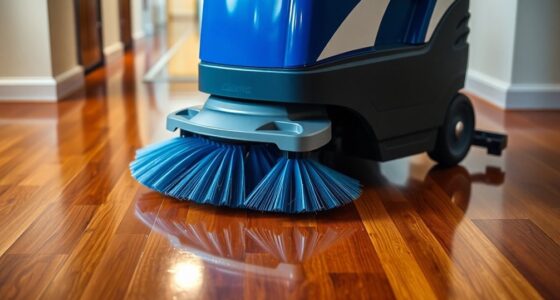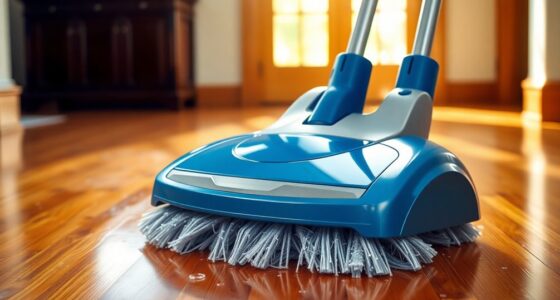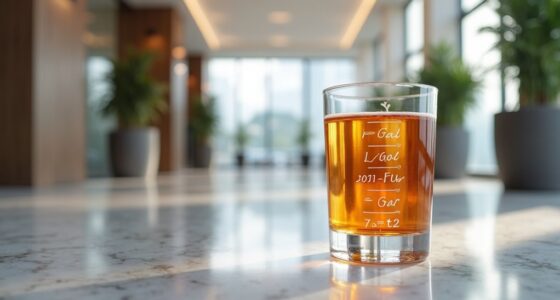To keep your vinyl plank floors in top shape, sweep or vacuum daily to remove loose dirt and debris, focusing on edges and corners. Weekly, give the floors a thorough clean with a soft-bristled scrubber or brush, using a vinyl-specific cleaner and gentle circular motions. Once a month, inspect for any damage or wear, and consider deeper cleaning or applying a protective coat. Staying consistent helps maintain their beauty; learn more about proper care techniques as you continue.
Key Takeaways
- Daily: Remove loose dirt with a vacuum or soft-bristle broom, then lightly mop with a damp cloth and vinyl-specific cleaner.
- Weekly: Vacuum or sweep thoroughly, then scrub problem areas with a soft-bristle or specialized floor brush, followed by a damp mop.
- Monthly: Inspect for damage, replace worn scrubber parts, deep clean with gentle circular scrubbing, and consider applying protective polish.
- Proper tools: Use a vacuum with a soft brush attachment, gentle cleaning solutions, and replace scrubber components regularly for optimal care.
- Maintenance tips: Maintain a routine, avoid excess water, focus on high-traffic zones, and address damage promptly to extend floor lifespan.

Maintaining your vinyl floors with a scrubber can keep them looking new and extend their lifespan. To achieve this, you need to develop a consistent cleaning routine that addresses daily, weekly, and monthly needs. Starting with daily care, you should focus on removing loose dirt and debris. Regular vacuum maintenance is essential because debris like dirt, sand, or grit can scratch the surface if left uncleaned. Make sure to vacuum your vinyl floors thoroughly each day, paying special attention to edges and corners where dirt tends to accumulate. Use a vacuum with a soft brush attachment to prevent scratching and ensure dirt is lifted effectively. After vacuuming, employ a proper mop technique for light mopping. Use a damp mop with a gentle cleaning solution specifically designed for vinyl floors. Avoid excess water, as too much moisture can seep into seams and cause damage over time. Wring the mop well before use, and move it in straight, overlapping strokes to pick up dust and light stains without pushing dirt around. This routine helps maintain the floor’s appearance and prevents buildup that could hinder deeper cleaning. Additionally, choosing the right cleaning products tailored for vinyl surfaces can prevent dulling and preserve the floor’s appearance.
Moving into weekly maintenance, you should do a more thorough cleaning to remove stubborn dirt and grime. Consider using a scrubber with soft bristles or a specialized floor brush attachment for your machine. Before scrubbing, sweep or vacuum again to remove loose dirt. When using the scrubber, choose a mild cleaning solution suitable for vinyl floors, and avoid harsh chemicals that can damage the surface. Focus on problem areas such as high-traffic zones or spots with stains. Be gentle with your scrubber to avoid dulling the finish; gentle circular motions usually work best. After scrubbing, follow up with a clean, damp mop to remove residual dirt and cleaning solution. Make sure to rinse your mop frequently to prevent spreading dirt around. This weekly deep clean helps restore the floor’s shine and keeps the surface smooth and free of grime buildup.
On a monthly basis, inspect your vinyl floors for signs of wear or damage. Check seams and edges for lifting or cracking, and address issues promptly to prevent further deterioration. Deep cleaning with a scrubber can be part of this routine, but it’s also a good time to examine your cleaning tools and solutions. Consider replacing worn-out pads or brushes on your scrubber to maintain effective cleaning. Additionally, you can apply a vinyl floor polish or protective coating to enhance durability and shine. Regularly maintaining your vacuum and following proper mop techniques not only prolongs the life of your floors but also ensures they stay attractive and safe for everyday use. Proper floor maintenance and choosing suitable cleaning methods can significantly extend the longevity of your vinyl flooring. With consistent care and attention, your vinyl floors will look their best for years to come.
Frequently Asked Questions
Can I Use Steam Mops on Vinyl Plank Floors?
You can use a steam mop on vinyl plank floors, but you need to prioritize steam mop safety for superior vinyl floor maintenance. Make sure the steam mop has a low or adjustable heat setting to prevent damage. Use it sparingly and avoid prolonged exposure to moisture. Always follow the manufacturer’s guidelines and test a small, hidden area first to ensure your vinyl floors won’t be harmed.
Are There Specific Scrubber Brands Recommended for Vinyl Floors?
Don’t reinvent the wheel—some brands stand out for vinyl floors. For gentle cleaning, look for brands like O-Cedar and Bona, which make soft scrubber types that won’t scratch your surface. Microfiber mops and gentle scrubbers are your best bets; avoid harsh brushes. Trust recommended brands to keep your floors shining without damage. Stick to these, and you’ll be surprised how easy maintenance can be!
How Often Should I Replace Scrubber Pads?
You should replace your scrubber pad every 50 to 100 hours of use, depending on the pad’s lifespan and the level of dirt you clean. Regularly inspect the pad for signs of wear, tearing, or buildup, and replace it when it becomes less effective. Maintaining proper replacement frequency guarantees your vinyl plank floors stay clean and protected, preventing scratches and damage caused by worn-out pads.
Is It Safe to Use Vinegar in Scrubbers?
Yes, using vinegar in scrubbers is generally safe, but you should verify the vinegar safety for your specific scrubber and flooring. Vinegar is a natural cleaner, but it can damage certain scrubber materials or vinyl floors if used excessively or undiluted. Always verify scrubber compatibility with vinegar and dilute it properly to avoid any potential harm. When in doubt, consult the manufacturer’s guidelines to ensure safe cleaning.
Can I Use a Scrubber on Heavily Stained Vinyl Areas?
Think of your scrubber as a knight facing a dragon—heavy stains won’t stand a chance! Yes, you can use a scrubber on heavily stained vinyl areas, but make certain it’s gentle enough to avoid scratches. For tough spots, a soft-bristled brush combined with a suitable cleaner boosts scrubber effectiveness. Keep in mind, patience is key—sometimes, multiple gentle passes work better than aggressive scrubbing.
Conclusion
By sticking to a daily, weekly, and monthly scrubber care routine, you’ll keep your vinyl plank floors looking brand new—like they just rolled off the showroom floor! Regular maintenance prevents grime from building up and keeps your floors shining brighter than a diamond. Think of your cleaning routine as a secret weapon that makes your space feel fresh and inviting every day. With consistent care, your floors will stay stunning for years to come—truly a feat of flooring magic!









